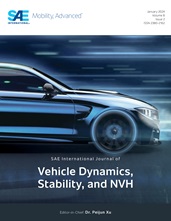Automotive Suspensions with Additional Spring in Series with Damper: Optimal Design by Analytical Formulae
- Features
- Content
- The basic optimal design of automotive suspensions with an additional spring in series with the damper is proposed. Unaddressed analytical expressions are derived for early design. A linear quarter-car model excited by a random road profile is considered. Multi-objective optimization (MOO) of the suspension performance is worked out analytically. Three analytical objective functions, namely, discomfort, road holding, and working space are derived and validated. Suspension spring stiffness, damping coefficient, and additional spring stiffness are considered as the design variables. The analytical optimization of three objective functions depending on three parameters has never been proposed in the literature, in reference to suspension systems. A quick selection of optimal suspension parameters is possible by using the analytical formulae of the Pareto-optimal set given in this article. The analytical optimal solutions are validated experimentally by resorting to the actual engineering practice. Despite the simplicity of the model, some understanding is provided on the advantages and disadvantages coming from the adoption of an additional spring in series with the damper in automotive suspensions.
- Pages
- 16
- Citation
- Yang, L., Ramakrishnan, K., Mastinu, G., Previati, G. et al., "Automotive Suspensions with Additional Spring in Series with Damper: Optimal Design by Analytical Formulae," SAE Int. J. Veh. Dyn., Stab., and NVH 4(3):259-274, 2020, https://doi.org/10.4271/10-04-03-0018.
